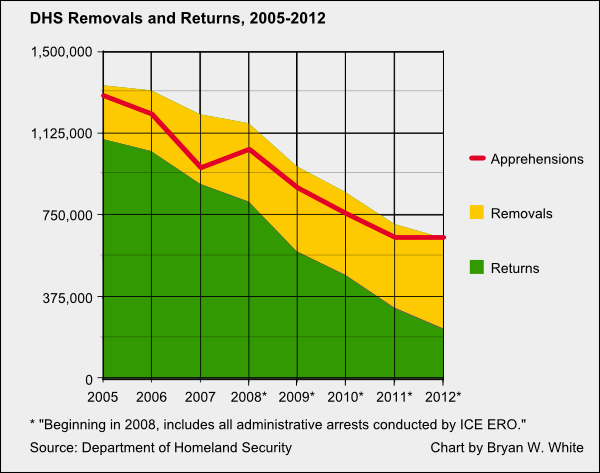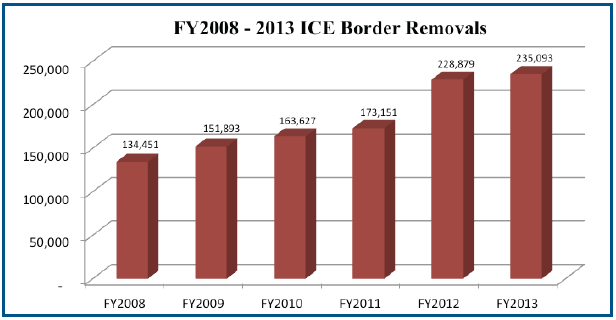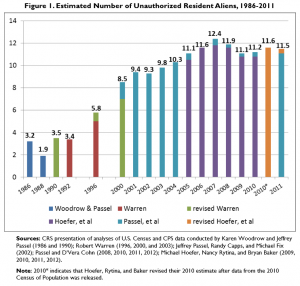 “It’s too soon to say that Obama has deported more people than any other president. But with the information available, it looks like he’s on track to do so. We rate her claim Half True.”
“It’s too soon to say that Obama has deported more people than any other president. But with the information available, it looks like he’s on track to do so. We rate her claim Half True.”
—PolitiFact, summarizing a March 9, 2014 fact check of National Council of La Raza president Janet Murguía
Overview
PolitiFact’s balancing act on President Barack Obama’s immigration enforcement record leaves readers uninformed. Is Obama the toughest president on illegal immigrants? Has Obama been lax on enforcement?
The Facts
PolitiFact first addressed President Obama’s immigration enforcement record in July 2010. Univision news anchor Jorge Ramos said “President Barack Obama has deported more people in his first year in office than George W. Bush in his last year in office.” PolitiFact rated the statement “Mostly True.”
PolitiFact’s next rating on deportation came in August 2012. Americans Principles in Action, a political action group PolitiFact linked to a conservative group, tried to appeal to Hispanics in Nevada by saying Obama had conducted more deportations than any other president in U.S. history. PolitiFact rated the claim “Half True.”
In 2014 PolitiFact again rated a claim about deportation. This time the claim came from Janet Murguía, president of the National Council of La Raza. Murguía said Obama has deported nearly 2 million people, more than any other U.S. president. PolitiFact rated the claim “Half True.”
In the following analysis, we’ll look at how PolitiFact informs or misinforms its readers on deportation and immigration enforcement.
Analyzing the Rhetoric
We’ll look first at how deportation fits in with border security and how it has changed since the Department of Homeland Security came into being. After that we’ll look at whether PolitiFact crafted its stories to support a narrative about President Obama’s enforcement of immigration law.
Deportation, removals and returns
The Department of Homeland Security defines “deportation” as removal, defined as follows:
Deportation – The formal removal of an alien from the United States when the alien has been found removable for violating the immigration laws. Deportation is ordered by an immigration judge without any punishment being imposed or contemplated. Prior to April 1997 deportation and exclusion were separate removal procedures. The Illegal Immigration Reform and Immigrant Responsibility Act of 1996 consolidated these procedures. After April 1, 1997, aliens in and admitted to the United States may be subject to removal based on deportability.
PolitiFact’s 2014 fact check fully accepts the equivalence of deportation and removal. But more complications exist under the surface. DHS also uses “returns” to send illegal immigrants out of the country.
Return: The confirmed movement of an inadmissible or deportable alien out of the United States not based on an order of removal.
While the number of removals has increased, the number of returns has decreased. At the same time, thanks mostly to the weak economy, fewer aliens are attempting to cross into the United States.
Our chart below shows removals and returns stacked to show the total number of deportable or inadmissible aliens leaving the country thanks to immigration enforcement. We also give the number of apprehensions reported by DHS. It’s clear that number tracks roughly the number of combined removals and returns.

Adding a twist to our set of statistics, DHS has changed the way it counts the numbers. An Al Jazeera interview published on April 11 of former U.S. Immigration and Customs Enforcement official John Torres tells part of that story (bold emphasis added):
Back in 2007, we started counting what we called voluntary returns. The reason that the agency started counting those numbers is because even though in some instances there are voluntary returns, the agency would still put people on a bus or van and expend resources getting them across the border. For accounting purposes we started counting, but we put an asterisk next to it saying these are numbers we hadn’t counted before. At some point the asterisk got lost and everything started getting counted.
They also started removing people arrested by the border patrol. Historically, CBP [Customs and Border Patrol] would do their own voluntary returns at the border and send them back using their own resources. That changed at some point over the last two to three years. Those arrests would get turned over to ICE. That’s where I believe those numbers would be somewhat artificially inflated. Removal is a catchall category for voluntary returns and deportations.
The change Torres mentions may account for much of the unusually high 31 percent increase in ICE border removals occurring in 2012.

Chart credit: ICE.gov
The official numbers for removals and returns tell us that removals are going up. And returns are going way down, leaving us a blurred picture of immigration enforcement.
Border enforcement vs. interior enforcement
We gain some clarity by comparing border enforcement to interior enforcement of immigration law. The director of policy studies for the Center for Immigration Studies, Jessica Vaughan, produced a report that uses government statistics to look at enforcement.
We’ll highlight two of the strongest points in Vaughan’s comprehensive argument.
Vaughan points out that every ICE field office issued a lower number of charging documents in Fiscal Year 2013 than in FY 2011.
Only Philadelphia and Phoenix, two out of 24 of the ICE field offices, increased their arrests of alien criminals from FY 2012 to FY 2013.
Vaughan concludes:
A better picture of the true state of immigration enforcement in the interior, where most illegal aliens have settled and where most Americans notice the impact, emerges from this analysis of ICE’s internal statistics and metrics. Interior enforcement activity, including arrests and removals of criminal aliens, which are ICE’s highest priority, has declined significantly. More than 870,000 aliens who have been ordered removed are still living here in defiance of our laws.
The ICE statistics back Vaughan’s conclusion. Now we look at whether PolitiFact’s narrative paints a similarly realistic picture.
PolitiFact’s immigration enforcement story
PolitiFact’s first deportation story, the one featuring Univision anchor Ramos, talked about rising deportation statistics. It did not mention the dropping number of returns. This story was from 2010, so it predated the figures above relating to decreased interior enforcement of immigration law. Ramos had criticized Obama for breaking a campaign promise. That context failed to find its way into PolitiFact’s story. PolitiFact at least offers a hint, though, that Ramos was critical of Obama’s record on deportation.
PolitiFact published its next deportation story in 2012, looking at a Nevada ad intended to help Republican challenger Mitt Romney in the election campaign against Obama. PolitiFact again failed to note the drop in returns, and reinforced a strong interior enforcement narrative. The story noted the possibility Obama was using selective enforcement on criminal aliens to gain support for immigration reform that would legalize non-criminal aliens.
PolitiFact’s 2014 foray into deportation fact checking finally acknowledged alien returns, but did not tell readers about the steep drop-off in returns. PolitiFact told its readers that returns are not technically deportations, which served to help justify ignoring ICE statistics in favor of those published in the DHS Yearbook:
Media outlets routinely cite ICE numbers. Here, we chose not to. Those numbers aren’t an accurate count of deportations, because they include returns. Also, ICE numbers don’t include deportations conducted by Border Patrol officers. So when we hear the word “deportations,” the public’s definition doesn’t line up with how ICE defines the action.
PolitiFact chooses not to use the ICE numbers since the ICE numbers don’t line up with the public’s definition of “deportation.” But what is the public’s definition of deportation? PolitiFact does not discuss the public’s view of the term in any of its three fact checks centered on deportation. As we note above, PolitiFact simply accepts that deportation equals removal, as defined by the DHS. Though ICE is an arm of the DHS, PolitiFact uses the DHS definition. Does the public understand that the government, by changing its procedures, artificially increased the number of removals conducted at the border?
Dictionary.com provides us two less technical definitions, both more likely to represent the public’s view of deportation:
1.
to expel (an alien) from a country; banish.
2.
to send or carry off; transport, especially forcibly: The country deported its criminals.
The first definition easily covers returns under its broad umbrella. And even the second definition is broad enough to cover returns. Recall that ICE started including returns in its data since it was using its resources to do the job. And the voluntary returns are not strictly voluntary. The alien opting for a voluntary return escapes potential criminal consequences by taking that route. The voluntary return occurs under a threat.
How does PolitiFact determine how the average person understands deportation?
We interviewed CIS’s Jessica Vaughan and she spoke to the way people perceive the term “deportation”:
I think most people would define deportation as “kicking a non-citizen out of the country.” ICE doesn’t use the word deportation except in the technical way, which for them means “the expulsion of an alien who was admitted to the country legally.” Two very different things.
PolitiFact used the DHS definition , passing it off as the public’s definition without making clear to readers how returns have sharply declined. Neither does PolitiFact address the reasons behind the changes. PolitiFact’s series of deportation stories supports a misleading narrative of robust immigration enforcement.

Chart by the Congressional Research Service, 2012
The state of U.S. immigration enforcement
President Obama’s immigration record can only count as mixed. Obama inherited a beefed-up border security force from President George W. Bush. But while the number of removals has increased to record levels, the overall number of aliens leaving as a direct result of immigration enforcement stands at its lowest level in decades. We should warn that DHS and ICE statistics count each separate removal or return event. The same alien can potentially count as removed or returned multiple times in the space of a year.
The Congressional Research Service produced a chart in 2012 showing the estimated population of unauthorized resident aliens. The chart shows that population growing since 2008 despite the high number of deportations and the lower number of illegal border crossings associated with the weak U.S. economy.
Executive orders and selective enforcement
During our interview with CIS’s Jessica Vaughan, she named three executive actions from Obama she said carried the most significant effects on immigration enforcement.
2011 Morton memo: This memo opened the way for ICE to use broadened prosecutorial discretion in immigration enforcement.
2012 restrictions on issuance of detainers: This memo directed ICE agents to refrain from issuing detainers unless undocumented aliens met certain conditions.
2012 deferred action for childhood arrivals: This executive action created an avenue for undocumented aliens coming to the United States as children to file for deferred action on their cases. The government would relax its efforts to enforce immigration law on those who qualify and allow them to apply for work permits.
These memos stand as part of a pattern of changing enforcement using prosecutorial discretion as a justification. The broadly applied rules for prosecutorial discretion have about the same effect as changing the wording of immigration law.
“The Obama administration,” Vaughan says, “has expanded the concept to the point where nearly all illegal aliens are considered worthy of prosecutorial discretion – the exception is the rule.”
The administration’s priorities leave most resident undocumented aliens with little to worry about from immigration enforcement. The government focuses its attention on the border and gooses deportation numbers by sending more border cases to an immigration judge. DHS reports removals and returns on the same spreadsheet for a reason, it seems to us. Removals and returns combined are far lower under Obama than under Bush or President Bill Clinton, and lower than under any president going back to the Nixon era.
When PolitiFact reports the administration is on track to set deportation records, it omits much of the story.
Summary
“It’s too soon to say that Obama has deported more people than any other president”
![]()

PolitiFact reports accurately on this point, though with some missing context.
“But with the information available, it looks like he’s on track to do so.”
Though we’re giving these key statements lenient ratings, PolitiFact has created a false narrative about President Obama’s immigration enforcement with its reporting. The deception in that narrative stems from the ambiguity of the term “deportation,” as explained above. The overall reporting in the three fact checks leads to the charge of fallacious one-sidedness. Obama’s deportation numbers are aided by oranges counted among the apples, and other immigration enforcement metrics show a president deliberately softening interior immigration enforcement.
PolitiFact doesn’t tell its readers how the government has changed its counting methods, and doesn’t dwell on the rapid drop in the rate of voluntary returns.
Update May 8, 2014: We belatedly added our interview of Jessica Vaughan to our source list.
References
Jacobson, Louis. “Obama Deported More People in His First Year than Bush Did in His Last, Spanish-language News Anchor Says.” PolitiFact.com. Tampa Bay Times, 06 July 2010. Web. 04 May 2014.
Jacobson, Louis. “Has Barack Obama Deported More People than Any Other President in U.S. History?” PolitiFact. Tampa Bay Times, 10 Aug. 2012. Web. 03 May 2014.
Kliegman, Julie. “Activist Janet Murguía Calls Obama ‘deporter-in-chief,’ Says He Has Deported More Immigrants than Other Presidents.” PolitiFact. Tampa Bay Times, 17 Mar. 2014. Web. 04 May 2014.
Wasem, Ruth Ellen. “Unauthorized Aliens Residing in the United States: Estimates Since 1986.” Fpc.state.gov. Congressional Research Service, 13 Dec. 2012. Web. 5 Apr. 2014.
Morton, John. “Prosecutorial Discretion Consistent with the Civil Immigration Enforcement Priorities of the Agency for the Apprehension, Detention, and Removal of Aliens.” ICE.gov. U.S. Department of Homeland Security, 17 June 2011. Web. 5 Apr. 2014.
Lynch, Gerard E. “Prosecution: Prosecutorial Discretion.” JRank Articles. Net Industries, n.d. Web. 05 May 2014.
Morton, John. “Civil Immigration Enforcement: Guidance on the Use of Detainers in the Federal, State, Local, and Tribal Criminal Justice Systems.” ICE.gov. U.S. Department of Homeland Security, 21 Dec. 2012. Web. 05 May 2014.
Napolitano, Janet. “Prosecutorial Discretion with Respect to Individuals Who Came to The United States as Children.” DHS.gov. U.S. Department of Homeland Security, 15 June 2012. Web. 05 Apr. 2014.
“Definition of Terms.” DHS.gov. U.S. Department of Homeland Security, n.d. Web. 05 May 2014.
“Deportation.” U.S. Citizenship and Immigration Services. U.S. Department of Homeland Security, n.d. Web. 04 May 2014.
Torres, John. “Experts Weigh In: How Should U.S. Immigration Be Reformed?” Interview. Aljazeera.com. Al Jazeera America, LLC., 11 Apr. 2014. Web. 06 May 2014.
Ramos, Jorge. “‘This Week’ Transcript: McCain.” Interview by Jake Tapper. ABC News. ABC News Network, 04 July 2010. Web. 06 May 2014.
“Overview.” ICE.gov. U.S. Department of Homeland Security, n.d. Web. 05 May 2014.
“Yearbook of Immigration Statistics 2012 Enforcement Actions.” DHS.gov. U.S. Department of Homeland Security, 2013. Web. 06 May 2014.
“FY 2013 ICE Immigration Removals.” ICE.gov. U.S. Department of Homeland Security, n.d. Web. 06 May 2014.
Thompson, Ginger, and Sarah Cohen. “More Deportations Follow Minor Crimes, Records Show.” The New York Times. The New York Times, 06 Apr. 2014. Web. 06 May 2014.
Tabirian, Alissa. “DHS Chief Johnson Confirms Inflation of Deportation Numbers.” The Foundry. The Heritage Foundation, 14 Mar. 2014. Web. 06 May 2014.
“Built to Last: How Immigration Reform Can Deter Unauthorized Immigration.” Immigration Policy Center. American Immigration Council, 20 May 2013. Web. 06 May 2014.
Olson, David. “ILLEGAL IMMIGRATION: Ways of Counting Deportations.” PEcom Blogs. Enterprise Media, 2 Apr. 2014. Web. 06 May 2014.
Gutierrez, Jennifer A. “Voluntary Departure vs. Voluntary Return vs. Deportation.” Immigration Texas. Jennifer A. Gutierrez, 18 Jan. 2013. Web. 06 May 2014.
Vaughan, Jessica. “Deportation Numbers Unwrapped.” CIS.org. Center for Immigration Studies, Oct. 2013. Web. 06 May 2014.
Vaughan, Jessica. “Catch and Release.” CIS.org. Center for Immigration Studies, Mar. 2014. Web. 06 May 2014.
Vaughan, Jessica. “Jessica Vaughan Interview April 7-10, 2014.” E-mail interview.






